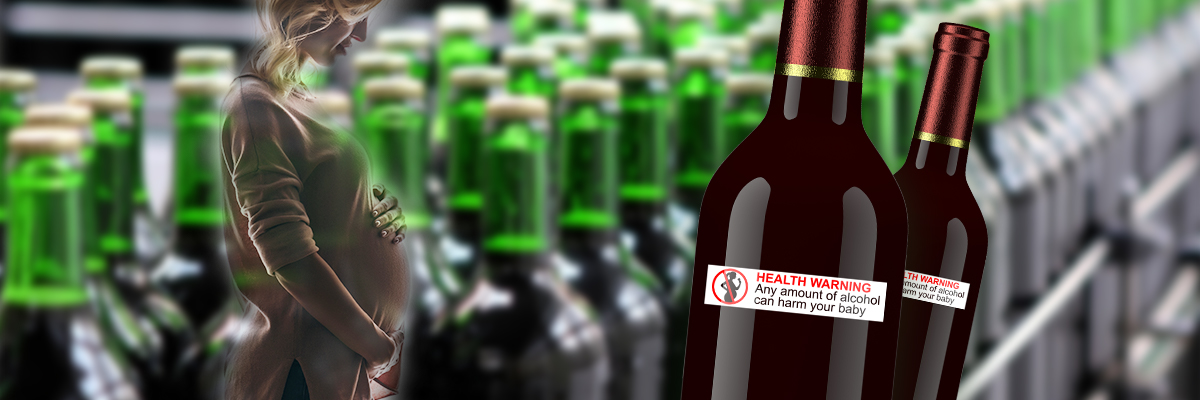Australia is tantalisingly close to getting the pregnancy warning labels on alcohol products that the community needs, deserves and has long demanded.
In 2018, in what was a huge win for the people in this country (both current and future), it was decided late in the year that all packaged alcohol products should have a mandatory pregnancy warning labels on all packaged alcohol products.
This was after eight long years of a voluntary labelling scheme implemented by the alcohol industry, which resulted in less than half (48%) of products having a label, being small in size and difficult to see. These failed in their objective to inform consumers about harm alcohol can cause during pregnancy.
Alcohol consumption during pregnancy is associated with a range of adverse consequences including miscarriage, stillbirth, low birth weights and Fetal Alcohol Spectrum Disorder (FASD).
FASD is associated with physical and emotional developmental delay, impaired speech and language development, learning problems and difficulty controlling behaviour. The effects of FASD are lifelong.
Consider this. The first application for pregnancy warning labels in this country was made all the way back in 1996.
Sadly, because Australia has taken so long to act, the children born in 1996 are likely to be having their own children. That is a whole 23 years where we have failed to inform consumers about these harms in a meaningful way.
After such a long wait, we are now at a critical juncture. This is an opportunity to implement a pregnancy warning label consistently and comprehensively applied on all packaged alcohol products.
And most importantly, implement elements that the evidence suggests are key to getting the message across.
The problem and the solution
The proposed mandated labelling scheme is being developed by Food Standards Australia New Zealand (FSANZ). But there are several issues that if not immediately addressed, will weaken the effectiveness of the new labelling scheme. These issues are:
- The proposed size of the pictogram and warning text is far too small. If implemented, the warnings will be well below the minimum standard set by FSANZ themselves for other warning labels.
- A smaller bottle does not mean smaller harm. The proposal that the full warning mark (pictogram and warning text) need only apply to products 200ml and above, will fail to cover products that are small in size but high in alcohol by volume.
- The proposed implementation time of two years is unreasonably long. Considering the urgency of the issue there is no good reason it should take this long.
- Pregnancy warning labels are not a silver bullet. Labelling reform is part of a wider prevention strategy to support women during pregnancy and these changes need to be accompanied by a comprehensive public awareness campaign.
Australia is on the cusp of getting the pregnancy warning labels on #alcohol products the community needs & deserves.
— FARE (@FAREAustralia) November 22, 2019
But there are several issues that need to be addressed to strengthen the effectiveness of the proposed labelling scheme.
➡️Take action: https://t.co/n1riW1RdX0 pic.twitter.com/3yGThSSNwZ
These deficiencies can be easily addressed. FARE has joined with a number of public health groups calling on FSANZ to correct the issues in the proposed scheme with the following changes:
- The size of the pictogram and warning text on products greater than 100ml needs to be increased, so these are easily visible to consumers.
- All alcohol products greater than 100ml have the full warning mark (pictogram and warning text) and that only containers less than 100 ml be permitted to display the pictogram by itself.
- All products will have a warning within 12 months after the gazettal of changes to the Food Standards Code. A 12-month transition period has successfully been applied in other countries and this will allow sufficient time for industry to adapt labelling to comply with the changes.
- A comprehensive public education campaign be funded to inform consumers about the changes, which should commence immediately prior to mandatory application of the labels.
You can make a difference
At this critical moment, we cannot fall short.
Data from the National Drug Strategy Household Survey demonstrates that the percentage of women who drink after knowledge of their pregnancy has plateaued since 2010, to 25 per cent women. Based on 2016 figures, this equates to around 76,000 women every 12 months consuming alcohol after knowledge of their pregnancy.
These changes to address the issues in the proposed labelling scheme will put the health and lives of women and children first through the introduction of a world-class pregnancy warning scheme on all packaged alcohol products.
We seek your help in calling on FSANZ to implement the best labelling scheme possible by clicking the link below and signing the letter.







